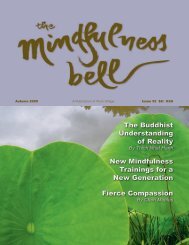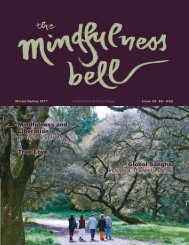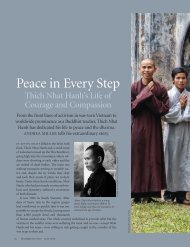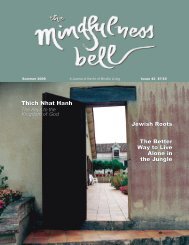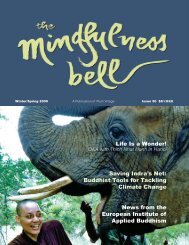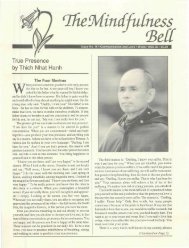Thich Nhat Hanh Healing in Vietnam The Wonderful World of Gathas
Thich Nhat Hanh Healing in Vietnam The Wonderful World of Gathas
Thich Nhat Hanh Healing in Vietnam The Wonderful World of Gathas
- No tags were found...
Create successful ePaper yourself
Turn your PDF publications into a flip-book with our unique Google optimized e-Paper software.
dharma TALK“I am tak<strong>in</strong>g each step <strong>in</strong> freedom for you, Father.”“I am breath<strong>in</strong>g gently, peacefully for you, Mother.”While we’re sitt<strong>in</strong>g still, sitt<strong>in</strong>g peacefully, there are three elementsthat we need to harmonize. <strong>The</strong> first is the body, the second is them<strong>in</strong>d, the third is the breath — m<strong>in</strong>d, body, and breath.Sometimes our body’s there but the m<strong>in</strong>d has run <strong>of</strong>f somewhereelse. It runs <strong>of</strong>f to the future, to the past. It is caught <strong>in</strong> worries,sadness, anger, jealousy, fear. <strong>The</strong>re is no peace, no stillness. Ifwe want to sit still we have to br<strong>in</strong>g the m<strong>in</strong>d back to the body.How can we br<strong>in</strong>g the m<strong>in</strong>d back to the body? <strong>The</strong> Buddhataught <strong>in</strong> the Sutra on M<strong>in</strong>dfulness <strong>of</strong> Breath<strong>in</strong>g that we need toknow how to use the breath. When we breathe <strong>in</strong>, we br<strong>in</strong>g them<strong>in</strong>d back to the breath. I am breath<strong>in</strong>g <strong>in</strong>, and I am aware that Iam breath<strong>in</strong>g <strong>in</strong>. Instead <strong>of</strong> pay<strong>in</strong>g attention to th<strong>in</strong>gs that happened<strong>in</strong> the past, th<strong>in</strong>gs that might happen <strong>in</strong> the future, we br<strong>in</strong>g them<strong>in</strong>d back so that it can pay attention to the breath.This sutra has been available <strong>in</strong> <strong>Vietnam</strong> s<strong>in</strong>ce the third century.Zen master Tang Hoi was the forefather <strong>of</strong> <strong>Vietnam</strong>ese Zenand this is one <strong>of</strong> the most basic sutras <strong>in</strong> meditation practice.Breath<strong>in</strong>g <strong>in</strong>, I know that I am breath<strong>in</strong>g <strong>in</strong>. Breath<strong>in</strong>g out, I ambreath<strong>in</strong>g out. This is the first exercise <strong>of</strong> the sixteen exercises <strong>in</strong>the Sutra on M<strong>in</strong>dfulness <strong>of</strong> Breath<strong>in</strong>g, which I have translatedfrom Pali to <strong>Vietnam</strong>ese and from Ch<strong>in</strong>ese to <strong>Vietnam</strong>ese; it hasbeen published <strong>in</strong> many languages.<strong>The</strong> day I discovered the Sutra on M<strong>in</strong>dfulness <strong>of</strong> Breath<strong>in</strong>g Iwas so happy! It is a wonderful sutra for our practice <strong>of</strong> meditation.If we practice wholeheartedly, <strong>in</strong> a few weeks we can br<strong>in</strong>g peaceand happ<strong>in</strong>ess back to our bodies and to our m<strong>in</strong>ds.Here is the first Dharma talk that <strong>Thich</strong> <strong>Nhat</strong> <strong>Hanh</strong> gave on his recent tour<strong>of</strong> <strong>Vietnam</strong>, at Phap Van Temple <strong>in</strong> Ho Chi M<strong>in</strong>h City on February 22, 2007.This excerpt presents the last part <strong>of</strong> the talk, <strong>in</strong>clud<strong>in</strong>g questions from theaudience and Thay’s answers. Later <strong>in</strong> this issue we <strong>of</strong>fer a story <strong>of</strong> thatday along with photos from the journey. To hear this talk <strong>in</strong> full, go to www.dpcast.org and look for “M<strong>in</strong>dfulness and <strong>Heal<strong>in</strong>g</strong> <strong>in</strong> <strong>Vietnam</strong>.”<strong>The</strong> Practices <strong>of</strong> the BuddhaIn Plum Village we have a gatha, a short poem that we memorize.It has only a few words.In, out.Deep, slow.Calm, ease.Smile, release.Present moment, wonderful moment!<strong>The</strong> first one, “<strong>in</strong>, out,” means breath<strong>in</strong>g <strong>in</strong>, I know that I’mbreath<strong>in</strong>g <strong>in</strong>. Breath<strong>in</strong>g out, I know that I’m breath<strong>in</strong>g out.<strong>The</strong> second one is “deep, slow.” Breath<strong>in</strong>g <strong>in</strong>, I see that my <strong>in</strong>breathhas become deeper. Breath<strong>in</strong>g out, I see that my out-breathhas become slower. In the beg<strong>in</strong>n<strong>in</strong>g our breath is very short, butif we cont<strong>in</strong>ue to follow our breath<strong>in</strong>g for a while, naturally our<strong>in</strong>-breath becomes slower, deeper, and our out-breath also becomesslower, more relaxed.This is our practice. Just as when we want to play the guitar,we have to practice every day, or if we want to learn to play tennis,we have to practice to be a good tennis player, we also haveto practice our breath<strong>in</strong>g. After one hour <strong>of</strong> practice we alreadyfeel better. <strong>The</strong>n slowly we’ll be able to sit still like the Buddha,and be worthy to be his disciples.Perhaps for a long time we have been go<strong>in</strong>g to the templeonly to do <strong>of</strong>fer<strong>in</strong>gs. But that’s not enough. We have to learn theteach<strong>in</strong>gs <strong>of</strong> the Buddha, the practices that the Buddha wanted totransmit to us.the M<strong>in</strong>dfulness Bell 5



